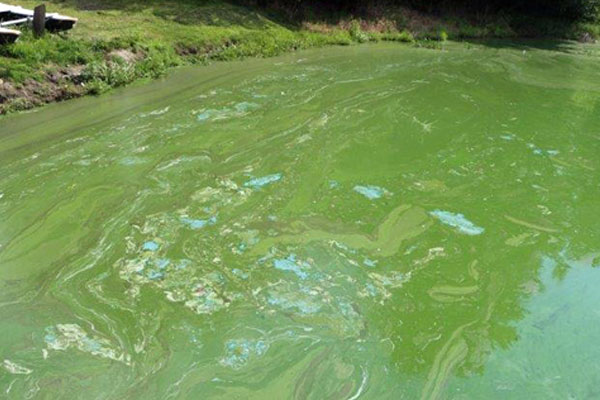Harmful Algal Blooms
Algae are an essential part of aquatic ecosystems - both freshwater and marine. These organisms can range in size from single-celled to mulitcellular. Although they usually contain chlorophyll and undergo photosynthesis, unlike true plants, algae lack stems, roots, and leaves.
Most of the time, algae are completely harmless, and their presence in a body of water is a sign that the ecosystem is healthy. They are low on the food web, which makes them an important source of nutrients for small aquatic organisms. However, some types of algae can grow fast and spread across the water. While not all of these algal blooms are dangerous, some are known as harmful algal blooms (HABs), and these should be avoided and reported immediately.
What Does It Look Like?

The most common HABs in the Adirondacks are called freshwater blue-green algal blooms. Blue-green algae is referred to as cyanobacteria and naturally occurs in lakes and streams. Cyanobacteria can expand into a harmful algal bloom under certain environmental conditions that allow it to take over other algae. Some of these conditions include too much sunlight and warmer temperatures, calm water, and excess nutrients. Once a harmful algal bloom grows, it may last for a few hours or weeks.
The problem with identifying harmful algal blooms is that they can appear in different forms. Since multiple types of algae can be present in a body of water, sometimes it's hard to tell toxic algae apart from harmless ones. Just to be safe, it's best to stay away from discolored water and blooms.
Identifying harmful algal blooms:
- Common colors are green, blue-green, yellow, brown, or red
- Green parallel streaks on the water's surface
- Consists of green dots or globs on the water's surface, similar to duckweed
- Looks like spilled paint and can be green, blue, or even white
- A pea soup quality with a bright green color
Note: Harmful algal blooms also occur off the New York coast and other saltwater shorelines. Depending on the color, these HABs may be referred to as a "red tide" or a "brown tide."
Identifying non-toxic algal blooms:
- Green algae on the water that look like floating rafts
- Hairy or silky green algae on rocks and the water's surface
- Bubbly green algae in small clumps
- The shape of a giant green tumbleweed in the water
- Thick mats of green algae
What Are The Effects Of Harmful Algal Blooms?
HABs can cause multiple symptoms in humans, including skin or throat irritations, allergic reactions, nausea, vomiting, and diarrhea. Sometimes, these symptoms are mistaken for food poisoning, gastrointestinal stress, or a different illness. If you think you've come in contact with a harmful algal bloom, the best course of action is to seek medical attention to determine the right treatment.
Additionally, if your pet or livestock comes in contact with a harmful algal bloom, you should seek a veterinarian immediately. Some blooms release a nerve or liver toxin that can become dangerous to animals quickly. Symptoms include loss of appetite, excessive salivating or drooling, fast heart rate, disorientation, and others.
What Can I Do About It?
To avoid harmful algal blooms, you should stay away from water that is discolored or is suspicious based on the types of visible algae. If you think you may have touched a harmful algal bloom, then you should rinse the algae off and contact a health professional.
For people that use public water systems, there is a very low chance of contact with harmful algal bloom toxins because public waterworks must abide by strict regulations. If a municipality detects a harmful algal bloom, then there will be a public warning, and chemicals will be added to the water supply to treat it effectively.
However, for people with private water systems, you should not drink untreated surface water. Naturally, untreated surface water may contain bacteria, parasites, or viruses, but if there's a harmful algal bloom, then it may also contain toxins. In this scenario, it's best to avoid drinking or using the water, and you should find an alternative, such as bottled water. In-home treatments, such as boiling, disinfecting with chlorine or ultraviolet, and water filters do not work against these toxins. Although blooms die off over time, you may want to get your water supply tested and contact the Department of Environmental Conservation (DEC).
If you have a pond or lake on your property, you can help prevent algal blooms by limiting lawn fertilization, making sure septic tanks are in good shape, reducing erosion, and maintaining water movement.
For more information, the DEC has a map that shows the location of current harmful algal blooms in New York State. The map is updated weekly.
If you suspect an algal bloom near you is toxic, the DEC also has a form you can fill out to report it.
« Return to Invasives & Harmful Plants Guide
Sources:
http://www.dec.ny.gov/chemical/81962.html
http://www.dec.ny.gov/chemical/91570.html#causes
http://www.dec.ny.gov/chemical/77118.html
Photo Courtesy of the Department of Environmental Conservation